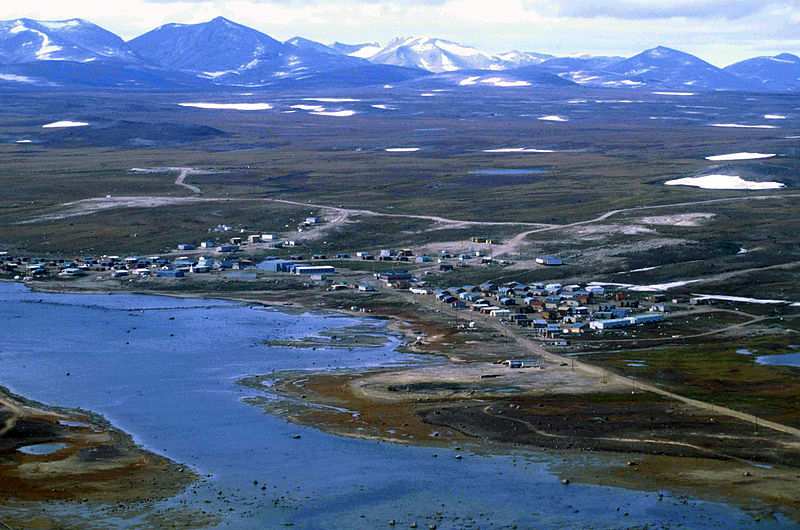Clyde River Community Climate Adaptation Plan

Photo attributed to Ansgar Walk. Incorporated here under the Creative Commons Attribution-Share Alike 2.5 Generic license. No endorsement by licensor implied.
Posted by
Rachel GreggProject Summary
Clyde River, like many small communities located in Nunavut, Canada, is threatened by melting permafrost and thinning sea ice due to a warming climate. To help prepare for the adverse impacts of climate change, the Clyde River community worked with partners to develop a community adaptation plan. Projects were designed to better understand the threat sea level rise, melting permafrost and change in freshwater availability could have on the community. The lessons learned from their experience are being applied to five other communities in Nunavut to help develop adaptation plans.
Background
Clyde River is located on the northeast of Baffin Island in Nunavut, Canada. It is a small community with roughly 900 residents. Warming temperatures are melting permafrost and causing unpredictable sea ice formation in the area; these impacts threaten the community’s infrastructure and alter traditional hunting routes. Clyde River and the community of Hall Beach piloted a climate change adaptation program developed for the entire region of Nunavut in 2006 at a three-day workshop held in Iqaluit. The goal of the workshop was to develop a climate change adaptation plan for Clyde River.
Collaborators learned many valuable lessons while working with the community to develop the community adaptation plan including:
- The importance of gaining community recognition early on;
- Improving communication between the scientists and the planners;
- Assuring the development process is long enough to adequately include community involvement;
- Establishing adaptation priorities;
- Translating documents into local languages; and
- Being sensitive and responsive to community traditions and cultural differences in communication methods.
Implementation
After the workshop, five projects were launched in Clyde River to help them assess the regional impacts of climate change and ways the community can adapt. Below is a short summary of the project titles, goals and outcomes.
- Sea level rise and coastal erosion: The goal of this project was to determine the rate of sea level rise in the community and to assess the coastal hazards that need to be considered in future city plans. Results indicate that the land is rebounding at a rate between 0-2mm/year; sea level may be rising at the same rate thus, the net change is a slight increase to none in relative sea level. Future work will develop projections for sea level in Clyde River.
- Terrain hazards and permafrost: The goal of this project was to better understand how ground conditions might change due to climate change. Old aerial photographs were used to identify landscape changes over time. They also looked at where rainfall is pooling and how meltwater is channeling to assess how and where the permafrost is melting. Sediment cores were used to identify the depth of the permafrost layer. Results were compiled to produce a composite terrain hazard map that identifies potential risk level across Clyde River.
- Water supply: The goal of this project was to better understand the depth and volume of lake water available to Clyde River. Ground surveys and aerial maps were used to estimate the area of the region’s watershed.
- Community climate change adaptation planning: Clyde River worked with the Canadian Institute of Planners, the Natural Resources Canada, Ittaq Heritage and Research Centre, Indian and Northern Affairs Canada, and the Government of Nunavut to develop an action-oriented climate change community adaptation plan. The final report prioritizes vulnerabilities and actions that will help the Clyde River community adapt to the adverse impacts climate change may present to the community. Strategies include:
- Review the community land use plan to incorporate climate change issues
- Provide equipment and training for residents to increase their safety while out on the land
- Develop a tourism plan to attract visitors, including cruise ships
- Record knowledge and experiences of residents’ changing travel and hunting conditions
- Share information and learn from others at meetings and conferences
- Continue the cooperation with scientists from Natural Resources Canada
Outcomes and Conclusions
The collaboration evolved into the Nunavut Climate Change Partnership, which aligns stakeholder interests with scientific recommendations to develop adaptation plans for local communities that are expected to be adversely impact by climate change. The Nunavut Climate Change Partnership then began working with five other communities – Iqaluit, Arviat, Whale Cove, Kugluktuk, and Cambridge Bay – to develop adaptation action plans.
A new website run by the Nunavut Climate Change Centre (NC3) was established to help local communities learn about the projected impacts climate change may pose to their communities. The website is a mix of scientific research on climate change, traditional ecological knowledge demonstrating climatic changes that have been passed down through generations, and an interactive map that allows users to learn more about the climate impacts and related projects that are ongoing in their local community.
Citation
Feifel, K. (2015). Clyde River Community Climate Adaptation Plan [Case study on a project of the Municipality of Clyde River and partners]. Product of EcoAdapt's State of Adaptation Program. Retrieved from CAKE: www.cakex.org/case-studies/clyde-river-community-climate-adaptation-plan (Last updated August 2015)


